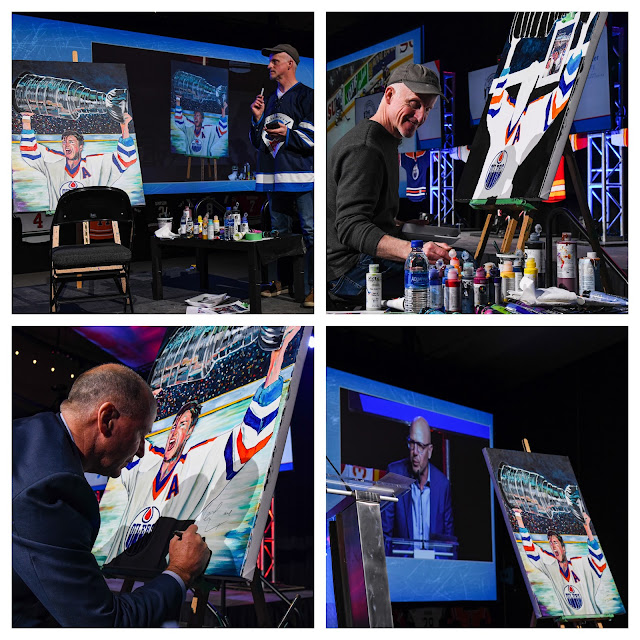Behind the scenes at a live painting event
I am at The Westin in Edmonton this morning, having my first cup of coffee. I drove up from Okotoks yesterday as doing the drive first thing in the morning would have been too exhausting. Energy preservation is an important part of live painting.
This process began a couple of months ago when Leslie reached out to confirm my availability. I have been working with her and her team for at least five years. They are the professional firm that organizes these massive fundraising hockey tournaments. It’s a winning formula that earns charities massive funds to do their good work. I’m a small side attraction in this social wealth generating mechanism.
Our first order of business is usually agreeing on the reference photo. In today’s case, the special guest is NHL great Bryan Trottier. The organizing committee selected a great shot that I will turn into a painting. A few days before the event, I spend a number of hours sketching out the subject on a large canvas. Today I will be working on a 36” x 48”. Working large plays better in a big hall filled with hundreds of guests, including a cadre of NHL alums.
I did two things differently on this project. I sketched it out using an acrylic paint pen. I then stained the canvas. It is sitting in a custom built box in my car, ready to be walked over to the Edmonton Convention Centre which is right around the corner from the hotel. I walked over my easel and painting tool kit last night. I’ll reverse the process when I’m done, likely around 2 pm.
After having my healthy breakfast of chef made muesli, I will go back to my room, pack up my things and head over to the venue. I spend the first hour acclimatizing myself to the space, setting up my paints and doing some posts on social.
I settle into my chair around 9 or 9:30 and start painting the boring, but vital, background things. At this point, I’m already thinking of where Mr. Trottier will sign. I need to make sure it is completely dry before the auction starts. In the first hour of laying down paint, the only people watching will be the banquet staff and technical folks who are doing their final preparations. The guests will start to pour in around 10:30 or so. By the time the program starts, over 700 people will fill the tables.
You might wonder if I get nervous. The truth is that the butterflies in my stomach tend to flutter more in the days leading up to the event rather than when I am actually doing it. Once I start painting, my internal clock starts ticking and the cacophony of sounds and activity surrounding me becomes my soundtrack to the experience. Some people come up and say hello, but generally I am really a side attraction that guests check out from time to time during the luncheon. The feature attraction is always a hot stove, where several hockey players tell stories and share insights about the game of hockey and their careers.
Over the many years of doing this, paintings created during my live painting performances have sold at auction from several thousand dollars up to twenty four thousand dollars. The amount is completely dependent on the subject, the energy and people in the room, and the auctioneer. I was personally disappointed at the result at this event last year. However, the $24,000 generated at the Calgary event a month later more than made up for it. My internal hope is that today’s painting will sell in the $10,000 range. Frankly, it is the one thing I can’t control.
When the painting is done and Mr. Trottier comes up to sign it, I usually try to whip out my phone to grab some pics. I do the same when the purchaser comes up for pictures at the end of the event.
I pack up my stuff, including the painting - as I always insist to take it back to the studio for final touch ups - and slip out of the room and back to my car. I will drive back to Okotoks as soon as I am wrapped up as my niece and her husband are popping by for a visit tonight.
Over the next few days, I do my final changes and apply a finishing coast of varnish before shipping the painting up to its new home.
From start to finish, it’s a lot of work, but I get paid well to do it and the charity makes a great deal of money to support its work. It’s win-win all the way around.



Comments
Post a Comment